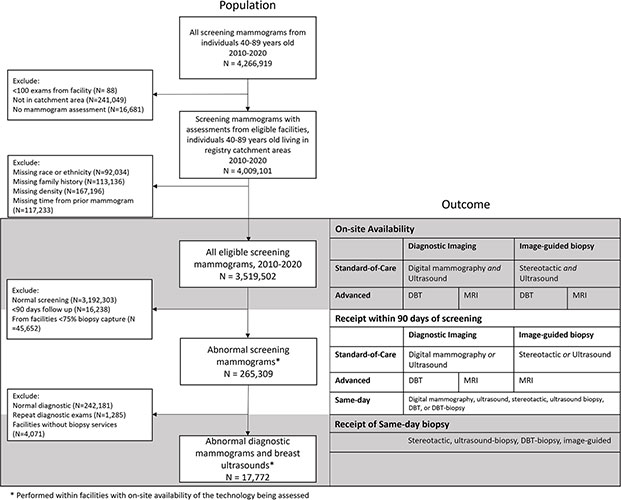Racial Disparities Seen in Same-Day Breast Diagnostic and Biopsy Services
Substantial differences seen in patients by race, ethnicity and neighborhood-level socioeconomic status

Different sociodemographic groups, especially racial and ethnic minorities, are less likely to receive timely breast cancer diagnostic services after an abnormal screening mammogram, according to a study published in Radiology.
When it is caught early enough, before symptoms are present, breast cancer can be easier to treat and significantly reduces a patient’s chance of dying of cancer. A delay in diagnosis can result in further progression of the disease and a poorer overall prognosis for the patient.
Receiving diagnostic services on the same day of an abnormal screening can aid in a timely cancer diagnosis. However, not all screening facilities offer additional diagnostic or same-day services. This means a potential delay in a cancer diagnosis for many patients.
Researchers from the University of Washington sought to identify if there is a link between sociodemographic factors and access to screening facilities with adequate diagnostic services.
“Many people are aware of the need to reduce disparities in the uptake of screening mammography. However, ensuring availability and receipt of quality diagnostic breast imaging is also necessary to diagnose breast cancer,” said study author Marissa B. Lawson, MD, MS, assistant professor of radiology at the University of Washington School of Medicine in Seattle. “Identifying and understanding the disparities in diagnostic breast imaging can facilitate the development of interventions that aim to close gaps in this care pathway and may ultimately improve breast cancer outcomes and patient satisfaction.”
Flowchart of study examination selection and outcomes assessed. Alternate horizontal shading is used to highlight the sample of examinations that corresponds with the outcomes of interest. DBT = digital breast tomosynthesis.
https://pubs.rsna.org/doi/10.1148/radiol.241673 © RSNA 2025
Interventions May Reduce Disparities
For this retrospective study, Dr. Lawson and colleagues compiled data from six Breast Cancer Surveillance Consortium breast imaging registries.
The data included over 3.5 million screening mammograms that were conducted on 1.1 million women at a total of 136 facilities located throughout the U.S. Of the 1,123,177 women, approximately 10% were Asian, 13% were Black, 6.5% were Hispanic, 68% were white, and 2.2% were “all others.” Of the 9.3% of screenings that resulted in abnormal mammograms, 265,309 examinations were included in the analysis evaluating same-day services.
Approximately 66% of the screening facilities performed same-day diagnostic services. Although onsite availability of most diagnostic services was similar across race and ethnicity groups, the researchers found that racial and ethnic minority groups were less likely to receive standard-of-care diagnostic imaging after abnormal screening compared with white patients.
“Despite having similar availability of diagnostic breast imaging services, there were substantial differences in whether patients received some of these services by race and ethnicity and neighborhood-level socioeconomic status,” Dr. Lawson said.
Racial or ethnic minorities were less likely to have access to some diagnostic technologies within 90 days of their abnormal screening. Compared to white patients, Asian and Black patients were less likely to undergo digital breast tomosynthesis.
Additionally, patients who identified as Asian, Black or Hispanic/Latinx were less likely to receive diagnostic imaging on the same day as their abnormal mammogram. However, Hispanic patients were more likely to receive same day biopsy in comparison to white or Black patients.
Patients living in neighborhoods with a lower average income also experienced disparities in access to diagnostic services.
The researchers note that some interventions may reduce disparities in timely breast cancer diagnosis, such as legislation to require health insurance plans to provide coverage of diagnostic breast imaging without out-of-pocket costs or the establishment of patient navigation services at facilities to help patients arrange timely appointments for diagnostic imaging.
“Future studies should assess other factors that may impact whether patients receive specific diagnostic breast imaging services, such as insurance status or patient preferences,” Dr. Lawson said. “In addition, we should seek to understand how diagnostic breast imaging accessibility, timeliness and quality ultimately impact breast cancer outcomes.”
For More Information
Access the Radiology study, “Disparities in Standard-of-Care, Advanced, and Same-Day Diagnostic Services among Patients with Abnormal Screening Mammography,” and the related editorial, “Breast Imaging Disparities Persist Despite Same-Day Service Availability.”
Read previous RSNA News stories on disparities in imaging access: